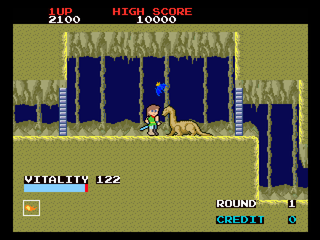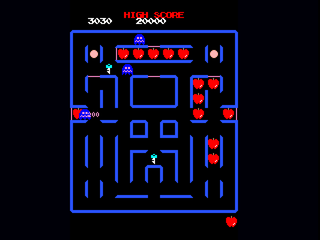Retro Replay Review
Gameplay
Namco Museum Vol. 2 offers a delightful buffet of arcade classics, each with its own unique mechanics and pacing. From the dot-gobbling corridors of Super Pac-Man to the vertically scrolling dogfights of Xevious, the compilation showcases the breadth of Namco’s early design creativity. Players can jump seamlessly from one genre to another, which keeps the experience fresh and engaging throughout long play sessions.
(HEY YOU!! We hope you enjoy! We try not to run ads. So basically, this is a very expensive hobby running this site. Please consider joining us for updates, forums, and more. Network w/ us to make some cash or friends while retro gaming, and you can win some free retro games for posting. Okay, carry on 👍)
Super Pac-Man modernizes the original formula with bigger mazes, rotating doors, and a variety of power-ups, making it a standout first course in the lineup. In Xevious, the tight, responsive controls allow skilled pilots to dodge enemy fire and uncover hidden bonus targets, ensuring that every run feels rewarding. Mappy injects platforming flair into the roster, tasking you with navigating multi-level mansions as a police mouse on the hunt for cat burglars.
Tank aficionados will find satisfaction in Grobda, where maneuvering your hover-tank through enemy lines demands both precision and quick reflexes. Dragon Buster introduces action-RPG elements—climbing towers, battling skeletons and dragons, and rescuing a princess—adding a rare sense of progression to the mix. Finally, Gaplus, the often-overlooked sequel to Galaga, steps up the complexity with enhanced enemy formations and multiple ship support, providing a fittingly frantic finale to the gameplay roster.
Beyond pure arcade port quality, Namco Museum Vol. 2 often includes helpful modern conveniences such as generous continue options and a responsive menu system for quick game switching. Whether you’re exploring every nook of the museum section or diving straight into your favorite title, the compilation’s flow never feels clunky. It’s a testament to how well these classics endure and adapt to contemporary playstyles.
Graphics
The visual presentation in Namco Museum Vol. 2 remains remarkably faithful to the original arcade cabinets, with pixel art reproduced in crisp clarity. On modern displays, sprites in Super Pac-Man and Mappy pop with vibrant colors, and each piece of fruit or door animation retains its original charm. There’s little hint of blur or distortion, making these decades-old games look right at home on contemporary hardware.
Xevious impresses with its layered backgrounds, where desert expanses and enemy installations scroll smoothly beneath your ship’s flight path. The sharp contrast between terrain and targets ensures bullets aren’t lost in the scenery, while occasional color palette shifts keep each stage visually distinct. Grobda’s steel-blue tanks gleam against darker backdrops, giving the battlefield a sense of depth that belies its simple graphic framework.
Dragon Buster’s design may appear rudimentary compared to later action-RPGs, but its bold character outlines and clear enemy silhouettes make every leap and slash satisfying to witness. Gaplus ups the ante with densely packed starfields and multicolored enemy waves, creating a kaleidoscopic spectacle when chains of captures light up the screen. Even today, the visual feedback in each game remains as legible and energetic as it was in the early ’80s.
Complementing the arcade ports is a robust museum section packed with concept sketches, cabinet art scans, and development diagrams. Viewing these high-resolution extras gives insight into the graphical evolution of each title—seeing hand-drawn character sheets for Pac-Man or early Xevious level layouts enriches appreciation for the finished product. It’s a treat for enthusiasts who want more than just the games themselves.
Story
While many arcade titles of this era focus squarely on high-score challenges rather than deep narratives, Namco Museum Vol. 2 still manages to impart character and context to each game. In Super Pac-Man, your yellow hero’s quest to munch every dot is dressed up with whimsical music and colorful level designs, making it feel like a lighthearted adventure rather than just a points chase.
Mappy’s cat-and-mouse premise provides a playful backdrop: you’re Officer Mappy, bouncing through mice-only mansions to recover stolen loot before the dastardly Meowkies escape. Each level’s layout introduces fresh strategic hurdles, turning what could be a simple platformer into a charming heist story. Even Grobda’s tank combat gains narrative weight when you imagine defending your base against onslaughts in futuristic warzones.
Dragon Buster stands out with its princes-and-puzzles motif: scaling the Tower of Druaga, you slice through skeletons and winged beasts to rescue a captive princess. Though the plot is bare-bones by modern standards, it’s delivered with enough heroic flair to give each dungeon crawl some dramatic purpose. Gaplus and Xevious provide a loose sci-fi framework—repelling alien fleets bent on Earth’s destruction—enough to lend urgency to your shooter trials.
The real storytelling magic lies in the extras: unseen developer notes, early storyboards, and candid interviews reveal the ideas and challenges behind each concept. Reading these museum pieces transforms a simple high-score excursion into a journey through gaming history, showing how narrative seeds planted here would later blossom in RPGs and modern adventure titles.
Overall Experience
Namco Museum Vol. 2 succeeds as both a nostalgic time capsule and an accessible entry point for newcomers. The six diverse arcade titles deliver hundreds of replayable stages, each with its own difficulty curve and scoring intricacies. Whether you’re chasing personal bests or exploring the museum’s treasure trove of behind-the-scenes artifacts, there’s always something new to discover.
The user interface is clean and responsive: selecting games, adjusting difficulty, or diving into the museum features never interrupts the flow. Soundtracks and effects retain their original punch, and an option to mute or adjust volume on individual titles ensures the music doesn’t overwhelm your session. For group sessions or shared arcade nights, the local multiplayer options in some titles add a social spark.
Collectors will find particular value in the extensive gallery of artwork, development commentary, and promotional materials. These extras feel lovingly curated, offering more than mere text blurbs—videos, gallery slideshows, and developer interviews flesh out the history behind each classic. It elevates this compilation above a simple software bundle into an interactive chronicle of Namco’s early arcade heritage.
Overall, Namco Museum Vol. 2 is a must-own for arcade aficionados and curious newcomers alike. Its blend of timeless gameplay, faithful emulation, and enriching bonus content creates a well-rounded package that celebrates the golden era of gaming. With six distinct titles and a wealth of historical insights, it stands as both an entertaining collection and a valuable reference for understanding the roots of modern interactive entertainment.
 Retro Replay Retro Replay gaming reviews, news, emulation, geek stuff and more!
Retro Replay Retro Replay gaming reviews, news, emulation, geek stuff and more!









Reviews
There are no reviews yet.